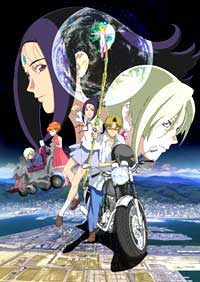For the next part of my series taking a look at mythology in anime, I'll be demonstrating some examples of Hindu mythology.
Example 1: RG Veda
As the title of the series would suggest, RG Veda is heavily inspired by Hindu mythology; specifically, the Rigveda, one of the four Vedas and a sacred text in Hinduism. Though the series takes many liberties with the nature of its references, it nonetheless remains heavily inspired by Hinduism, as is evident by the inclusion of several notable deities and creatures. The characters Taishakuten and Rasetsu are inspired by the deities Indra and Shachi, respectively, and the characters Ashura. Yasha-o, Ryu-o, Kendappa-o, and Karua-o are each inspired by the mythological creatures known as asuras, yaksha, naga, gandharvas, and garuda. Although the roles of several of these characters only have a tangential connection to their mythological inspiration, they do retain certain aspects of their original roles, such as the asuras' predisposition to violence and Indra's somewhat intolerable behavior.
 Example 2: Earth Maiden Arjuna
Example 2: Earth Maiden Arjuna
Earth Maiden Arjuna is an interesting example in that while it lacks many direct references to Hindu mythology, many of the themes of the series are based heavily on Hinduism. In terms of direct references, the title is the most obvious example: Arjuna was the name of the protagonist of the Mahabharata and was a legendary bowman, which is why the protagonist of Earth Maiden Arjuna wields a bow. Other direct examples include the malevolent bacteria known as the Raaja, referencing the metaphysical disease called the Roga, and the presence of a mechanical guardian called an Ashura, based on the mythological beings known as the asuras. Aside from these examples, much of the plot of the series is based heavily on the famous Hindu scripture called the Bhagavad Gita in terms of themes; a young boy acting as a guide for the protagonist is modeled after the legendary Krishna, the protagonist fills the role of Arjuna himself, and the plot contains many of the same elements relating to the concepts of war, peace, and morality that are depicted and discussed in the Gita.
 Example 3: Legend of Heavenly Sphere Shurato
Example 3: Legend of Heavenly Sphere Shurato
Legend of Heavenly Sphere Shurato is a series that makes use of many direct references to Hindu mythology. Most prominently, one of the main characters of the series is a spirit princess named Lakshu of Horaisan whi encounters the protagonist early in the story; she is based on the Hindu goddess Lashmi, the goddess of beauty, fortune, love, prosperity, and wealth. In addition, several Hindu deities direct appearances in the show, albeit with some creative liberties taken regarding their respective roles, including Shiva, Acala, Vishnu, and Indra. Lastly, several characters contain references to multiple concepts and beings within Hindu mythology, including the concepts of the Kundalini and the Trailokya and the entities known as the asuras and the yaksha.
Example 1: RG Veda
As the title of the series would suggest, RG Veda is heavily inspired by Hindu mythology; specifically, the Rigveda, one of the four Vedas and a sacred text in Hinduism. Though the series takes many liberties with the nature of its references, it nonetheless remains heavily inspired by Hinduism, as is evident by the inclusion of several notable deities and creatures. The characters Taishakuten and Rasetsu are inspired by the deities Indra and Shachi, respectively, and the characters Ashura. Yasha-o, Ryu-o, Kendappa-o, and Karua-o are each inspired by the mythological creatures known as asuras, yaksha, naga, gandharvas, and garuda. Although the roles of several of these characters only have a tangential connection to their mythological inspiration, they do retain certain aspects of their original roles, such as the asuras' predisposition to violence and Indra's somewhat intolerable behavior.
 Example 2: Earth Maiden Arjuna
Example 2: Earth Maiden ArjunaEarth Maiden Arjuna is an interesting example in that while it lacks many direct references to Hindu mythology, many of the themes of the series are based heavily on Hinduism. In terms of direct references, the title is the most obvious example: Arjuna was the name of the protagonist of the Mahabharata and was a legendary bowman, which is why the protagonist of Earth Maiden Arjuna wields a bow. Other direct examples include the malevolent bacteria known as the Raaja, referencing the metaphysical disease called the Roga, and the presence of a mechanical guardian called an Ashura, based on the mythological beings known as the asuras. Aside from these examples, much of the plot of the series is based heavily on the famous Hindu scripture called the Bhagavad Gita in terms of themes; a young boy acting as a guide for the protagonist is modeled after the legendary Krishna, the protagonist fills the role of Arjuna himself, and the plot contains many of the same elements relating to the concepts of war, peace, and morality that are depicted and discussed in the Gita.
 Example 3: Legend of Heavenly Sphere Shurato
Example 3: Legend of Heavenly Sphere ShuratoLegend of Heavenly Sphere Shurato is a series that makes use of many direct references to Hindu mythology. Most prominently, one of the main characters of the series is a spirit princess named Lakshu of Horaisan whi encounters the protagonist early in the story; she is based on the Hindu goddess Lashmi, the goddess of beauty, fortune, love, prosperity, and wealth. In addition, several Hindu deities direct appearances in the show, albeit with some creative liberties taken regarding their respective roles, including Shiva, Acala, Vishnu, and Indra. Lastly, several characters contain references to multiple concepts and beings within Hindu mythology, including the concepts of the Kundalini and the Trailokya and the entities known as the asuras and the yaksha.

No comments:
Post a Comment